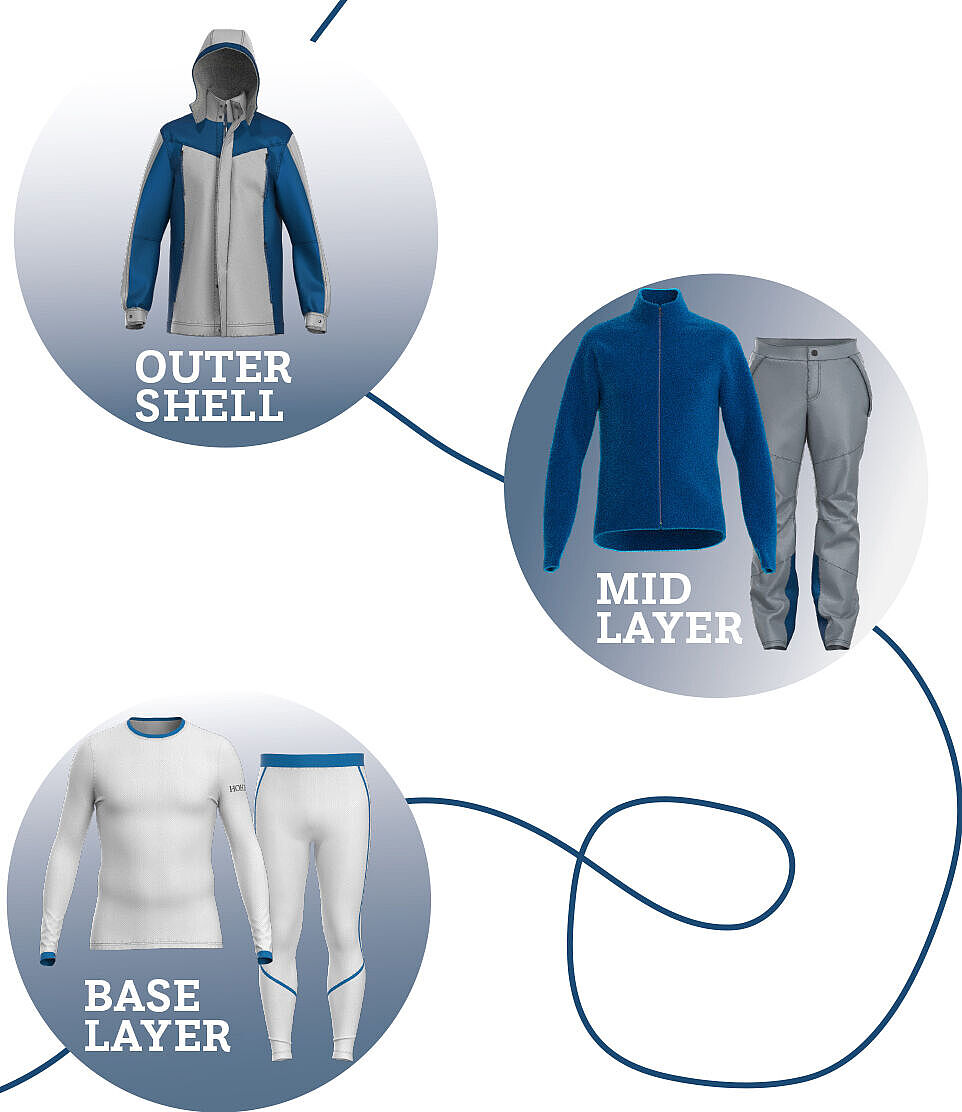Test criteria
The product performance of clothing, especially sports and outdoor textiles, can be tested and classified using the test methods of the DIN CEN/TR 16422 standard. The underlying tests are ideally suited for characterizing the thermoregulatory properties of clothing layers depending on the application.
Since it is not possible to combine all properties in a single garment, a clothing system consisting of several layers is often recommended for sports and outdoor textiles.
What are clothing layers?
Base Layer
The lower layer of clothing, commonly referred to as the "second skin" - is worn directly on the skin and should effectively absorb and wick away sweat.
Mid Layer
The mid layer of clothing provides most of the insulation by trapping and storing warm air.
Outer shell layer
The outer layer of clothing protects the wearer from external environmental factors, such as wind or rain.

What does the Hohenstein Performance Index evaluate?
The Hohenstein Performance Index evaluates the following basic functions of outdoor clothing, which determine the wearing comfort as well as the thermoregulatory properties of textile products.
The thermoregulation model of human skin - called skin model for short - is a measuring device that simulates both dry and sweating human skin. The skin model is used to determine material-specific, thermophysiological parameters of textiles as a surface material according to DIN EN ISO 11092.
When determining the thermal resistance - thermal insulation for short - the wearing condition is described in which there is a constant flow of heat from the wearer's body to the environment over time. The results provide information about the thermal insulation of the material.
A prerequisite for the award of the label is that the requirements of the DIN CEN/TR 16422 standard for the thermoregulatory properties of the clothing layer are met. The quality label is based on a test report with detailed results.
The thermoregulation model of human skin - called skin model for short - is a measuring device that simulates both dry and sweating human skin. The skin model is used to determine material-specific, thermophysiological parameters of textiles as a surface material according to DIN EN ISO 11092.
When determining the water vapor transmission resistance - breathability for short - the wearing condition is described in which there is a constant flow of moisture from the wearer's body to the environment over time and moisture is released from the skin, in the form of water vapor. However, similar to thermal insulation, the water vapor transmission resistance of a textile depends on the thickness of the textile. Therefore, the water vapor transmission index puts breathability and thermal insulation in relation to each other, so that a statement can be made about the water vapor transport capacity of the textile, independent of the material thickness.
A prerequisite for the award of the label is that the requirements of the DIN CEN/TR 16422 standard for the thermoregulatory properties of the clothing layer are met. The quality label is based on a test report with detailed results.
For the evaluation of product performance, especially of base layer garments (textiles worn close to the skin), sweat management is of great importance. When determining the buffering effect of liquid sweat and sweat transport according to DIN CEN/TR 16422 Annex B, the wearing condition is described in which the wearer sweats so much that liquid sweat occurs. In general, base layer materials should be able to rapidly absorb the sweat produced by the wearer and dissipate it to the environment.
A prerequisite for the label to be awarded is that the requirements set out in the DIN CEN/TR 16422 standard for the thermoregulatory properties of the clothing layer have been met. The quality label is based on a test report with detailed results.
Air permeability is determined in accordance with the DIN EN ISO 9237 standard by clamping a flat material specimen in the test instrument and setting the air flow to a specified differential pressure. The air velocity is the volume of air per unit of time and area that flows through the sample.
A prerequisite for the award of the label is that the requirements according to the DIN CEN/TR 16422 standard for the thermoregulatory properties of the clothing layer are met. The quality label is based on a test report with detailed results.
Textiles that are labeled waterproof should not allow water to pass through at all. Even after a longer stay in the rain, the wearer should remain completely dry under a waterproof outer shell garment. The hydrostatic pressure test according to DIN EN ISO 20811 tests the resistance of textiles to water penetration.
Textiles that are water-repellent remain dry on the outside. The fabric does not absorb water. Rain or other liquids bead off the surface. This effect is maintained if the fabric is exposed to rain for a longer period of time, but water can penetrate between the individual fibers under continuous pressure. Even then, water does not penetrate the fiber (the fabric remains dry), but moisture can push past the fibers and into the interior. The water-repellent properties are tested in accordance with DIN EN 29865 using a Bundesmann sprinkling tester.
A prerequisite for the award of the label is that the requirements according to the DIN CEN/TR 16422 standard for the thermoregulatory properties of the clothing layer are met. The quality label is based on a test report with detailed results.
All tests are based on test reports with detailed results
To the product factsheet
